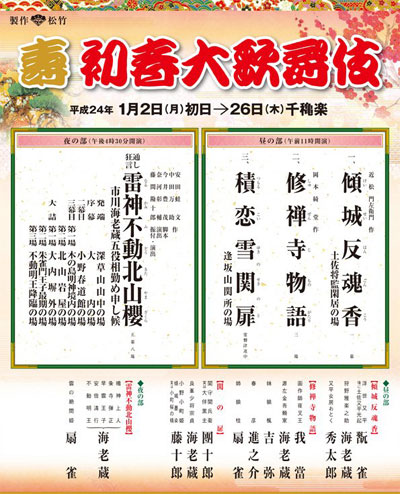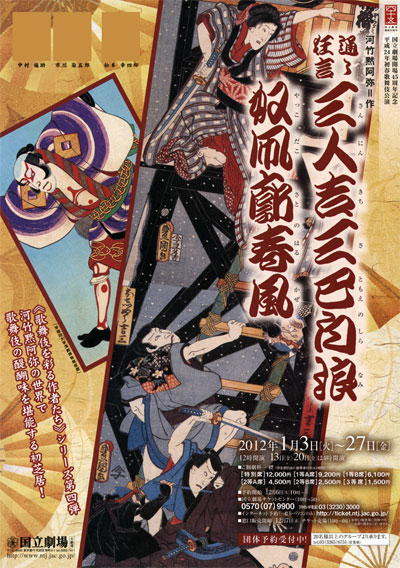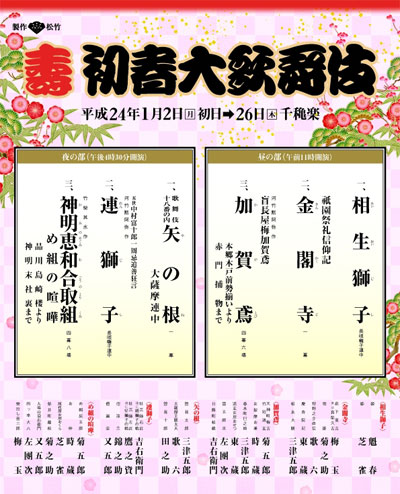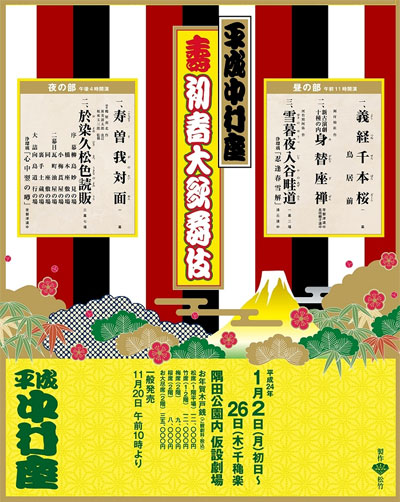| JANUARY 2012 |
|
2 in ďsaka (Sh˘chikuza), 9 shows in T˘ky˘ (National Theatre, Asakusa K˘kaid˘, Shinbashi Enbuj˘, Theatre Ginza, Heisei Nakamuraza, Zenshinza Gekij˘) and 1 in Ky˘to (Minamiza)!
|
| Sh˘chikuza (ďsaka) |
| Dates | 2 ~ 26 January 2012 (Kotobuki Hatsuharu ďkabuki) Congratulation Early Spring Grand Kabuki |
| MatinÚe |
Keisei Hangonk˘ (Domo Mata) |
| Evening | |
| Casting |
Sakata T˘jűr˘, Ichikawa Danjűr˘, Kataoka Gat˘, Nakamura Kanjaku, Kataoka Hidetar˘, Nakamura Senjaku, Ichikawa Ebiz˘, Ichikawa Ukon, Ichikawa Monnosuke, Ichikawa Emiya, Ichimura Kakitsu, Kataoka Ichiz˘, Kataoka Shinnosuke, Kamimura Kichiya, Sawamura S˘nosuke |
| Comments |
T˘shi ky˘gen production of the spectacular drama "Narukami Fud˘ Kitayama Zakura", which was premiered in ďsaka 270 years ago, in the 1st lunar month of 1742 in ďsaka at the ďnishi no Shibai [casting]. Ichikawa Ebiz˘ plays the roles of .
|
 |
| National Theatre (T˘ky˘) |
| Dates | 3 ~ 27 January 2012 (Hatsuharu ďkabuki) Early Spring Grand Kabuki |
| Program |
Sannin Kichisa Tomoe no Shiranami Yakko Dako Sato no Harukaze |
| Casting |
Matsumoto K˘shir˘, Nakamura Fukusuke, ďtani Tomoemon, Ichikawa Somegor˘, Ichikawa Komaz˘, Matsumoto Kingo, Ichikawa Juen, Nakamura Utae, Matsumoto Kintar˘, ďtani Hirotar˘, ďtani Hiromatsu |
| Comments |
|
 |
| Shinbashi Enbuj˘ (T˘ky˘) |
| Dates | 2 ~ 26 January 2012 (Kotobuki Hatsuharu ďkabuki) Congratulation Early Spring Grand Kabuki |
| MatinÚe | |
| Evening | |
| Casting |
Onoe Kikugor˘, Nakamura Kichiemon, Band˘ Mitsugor˘, Nakamura Tokiz˘, Nakamura Baigyoku, Nakamura Kaishun, Nakamura Shibajaku, Onoe Kikunosuke, Nakamura Kinnosuke, Sawamura Tanosuke, Ichikawa Sadanji, Ichikawa Danz˘, Band˘ Hikosabur˘, Nakamura T˘z˘, Nakamura Matagor˘, Nakamura Karoku, Kawarasaki Gonjűr˘, Ichimura Manjir˘, Band˘ Shűch˘, ďtani Keiz˘, Sawamura Yoshijir˘, Band˘ Kamesabur˘, Band˘ Kametoshi, Nakamura Matsue, Onoe Matsuya, Nakamura Baishi, Nakamura Takanosuke, Fujima Taiga |
| Comments |
|
 |
| Heisei Nakamuraza (T˘ky˘) | |
| Dates | 2 ~ 26 January 2012 (Kotobuki Hatsuharu ďkabuki) Congratulation Early Spring Grand Kabuki |
| MatinÚe | |
| Evening | |
| Casting |
Nakamura Kanzabur˘, Nakamura Hashinosuke, Nakamura Shid˘, Band˘ Yajűr˘, Kataoka Kamez˘, Nakamura Shichinosuke, Nakamura Baishi, Band˘ Shingo, Nakamura Mantar˘ |
| Comments |
The Heisei Nakamuraza is back in T˘ky˘ in the popular district of Asakusa. This time, it is a 7-month project (performances up to May 2012!) for this temporary theater built within the Sumida Park.
|
 |
|
|||
| Dates | 2 ~ 26 January 2012 (Shinshun Hanagata Kabuki) New Year Young Actors Kabuki |
||
| MatinÚe |
Otoshidama (Nenshi Goaisatsu) |
||
| Evening |
Otoshidama (Nenshi Goaisatsu) |
||
| Casting |
Ichikawa Kamejir˘, Kataoka Ainosuke, Nakamura Kikaku, Ichikawa Omez˘, Band˘ Takesabur˘, Ichikawa Shun'en, Band˘ Shinsha, Band˘ Minosuke, Nakamura Kash˘, Nakamura Kazutar˘ |
||
| Comments |
The yearly show for young promising actors at the Asakusa K˘kaid˘ in Asakusa, a lively and colorful neighboorhood that keeps the scent of old Edo.
|
||
| Le Theatre Ginza (T˘ky˘) |
| Dates | 2 ~ 26 January 2012 (Band˘ Tamasabur˘ Hatsuharu Tokubetsu K˘en) Band˘ Tamasabur˘ Early Spring Special Performances |
| Program |
|
| Casting |
Band˘ Tamasabur˘, Onoe Sh˘roku, Ichikawa Emisabur˘, Onoe Ukon, Ichikawa En'ya |
| Comments |
|
|
|||
| Dates | 3 ~ 22 January 2012 (Zenshinza K˘en) | ||
| Program |
Meiji Obake Goyomi |
||
| Casting |
Nakamura Umenosuke, Arashi Keishi, Kawarasaki Kunitar˘, Fujikawa Yanosuke, Arashi Yoshisabur˘, Yamazaki Tatsusabur˘, Ikushima Kigor˘, Matsunami Kihachir˘ |
||
| Comments |
The Zenshinza troupe celebrates in Ky˘to its 80th anniversary! |
||
 |
| Zenshinza Gekij˘ (Kichij˘ji) |  |
| Dates | 3 ~ 9 January 2012 |
| Program |
Kamikazari Hatena no Karakuri |
| Casting |
??? |
| Comments |
A newly-created Kabuki drama performed by the young actors of the Zenshinza troupe. The script was written by ďzakaya Happo. |
|
|
| Contact | Main | Top | Updates | Actors | Plays | Playwrights | Programs | Links | FAQ | Glossary | Chronology | Illustrations | Prints | Characters | Derivatives | Theaters | Coming soon | News |
|
|
| Contact | Main | Top | Updates | Actors | Plays | Playwrights | Programs | Links | FAQ | Glossary | Chronology | Illustrations | Prints | Characters | Derivatives | Theaters | Coming soon | News |